Aquatic Invertebrates
Media
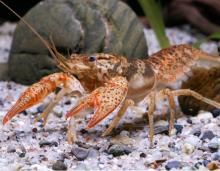
Species Types
Scientific Name
Faxonius hylas (formerly Orconectes hylas)
Description
The woodland crayfish is stout, reddish tan to dark brown, with numerous blackish specks and blotches on the pincers, carapace, and abdomen. It occurs only in Missouri, especially in the Black River and its tributaries.
Media
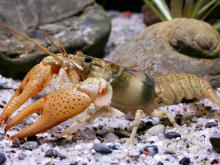
Species Types
Scientific Name
Faxonius ozarkae (formerly Orconectes ozarkae)
Description
The Ozark crayfish is light brown to reddish brown with numerous black specks on the pincers and often on the abdomen as well. The pincers are broad and powerful. It lives in the White and Black stream systems.
Media

Species Types
Scientific Name
Lacunicambarus ludovicianus (syn. Cambarus ludovicianus)
Description
The painted devil crayfish is a burrowing lowland species. In Missouri, it is known from only a few locations in the Bootheel. Its overall color is olive green to blue, with reddish and cream markings.
Media

Species Types
Scientific Name
Procambarus gracilis
Description
The grassland crayfish is rather uniformly colored either bright red or reddish and has broad, powerful pincers. It inhabits prairies and grasslands from Wisconsin and Indiana to Texas, including grasslands in northern and western Missouri.
Media

Species Types
Scientific Name
Faxonius medius (formerly Orconectes medius)
Description
The saddleback crayfish has a bold blackish band across the hind margin of the carapace and lacks dark blotches or specks. The pincers are broad and powerful. It occurs in the Big and Meramec river drainages.
Media
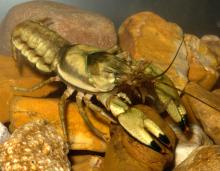
Species Types
Scientific Name
Faxonius neglectus (formerly Orconectes neglectus)
Description
The ringed crayfish is olive green to reddish tan and usually has black or brown rings around the pincer tips. In Missouri it is found in clear, rocky Ozark streams in the southwestern quarter.
Media
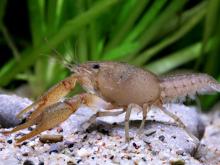
Species Types
Scientific Name
Procambarus viaeviridus
Description
Adult vernal crayfish are rusty red with a blackish wedge-shaped central stripe along the length of the abdomen. In Missouri, this species occurs only in our southeastern swamps and is usually only seen in February and March.
Media
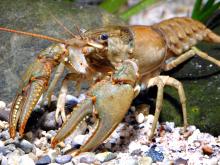
Species Types
Scientific Name
Faxonius virilis (formerly Oronectes virilis)
Description
The virile crayfish is large, reddish brown or green, and lacks prominent markings. The pincers are green with orange tips and are studded with whitish knobs. Paired dark blotches run along the abdomen. This species is widespread.
Media
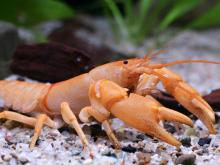
Species Types
Scientific Name
Cambarus hubbsi
Description
Hubbs' crayfish is powerfully built, olive tan or reddish brown, with a narrow blackish band where the carapace and abdomen join. It has a limited range within the Ozarks of southern Missouri and northern Arkansas.
Media

Species Types
Scientific Name
Faxonius punctimanus (formerly Orconectes punctimanus)
Description
The spothanded crayfish is moderately large and usually has a noticeable black spot on each pincer near the base of the movable finger. In Missouri, it is found mostly in Ozark waterways in the southeastern quarter of the state, from Callaway, Montgomery, and Warren counties south.
See Also
About Aquatic Invertebrates in Missouri
Missouri's streams, lakes, and other aquatic habitats hold thousands of kinds of invertebrates — worms, freshwater mussels, snails, crayfish, insects, and other animals without backbones. These creatures are vital links in the aquatic food chain, and their presence and numbers tell us a lot about water quality.





















